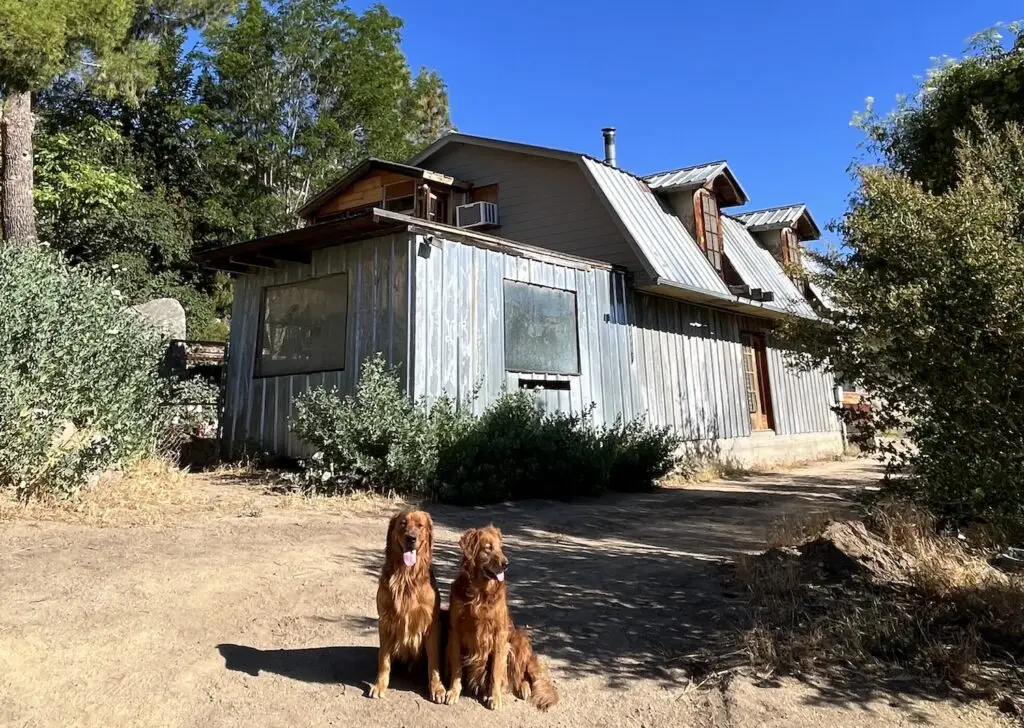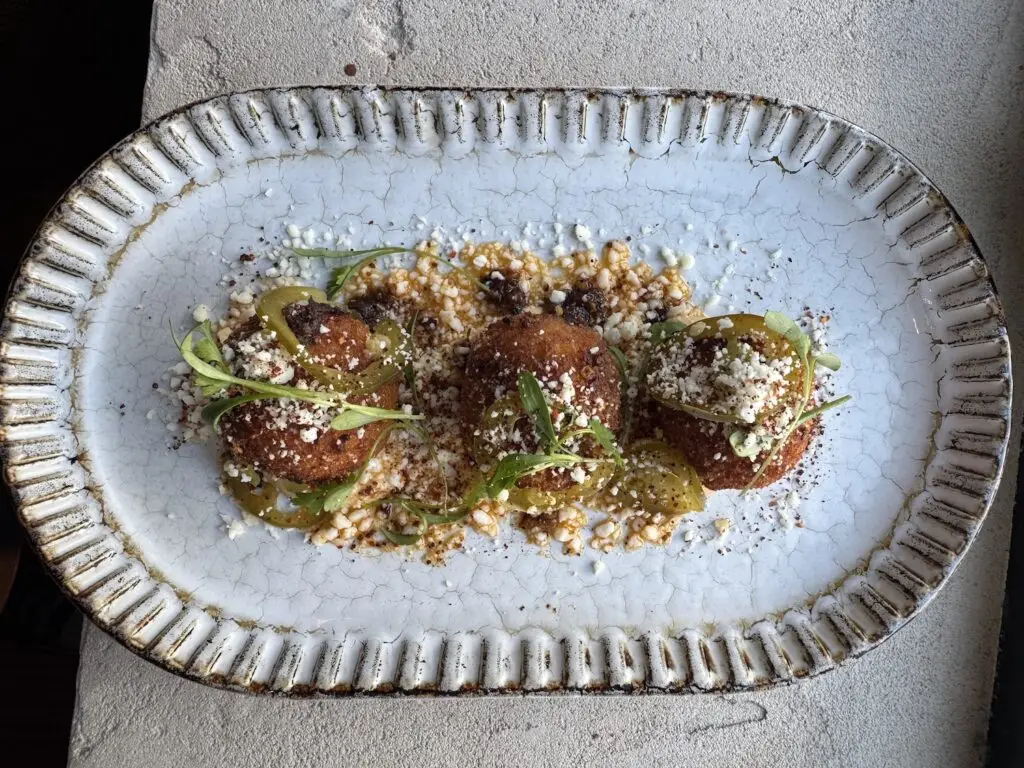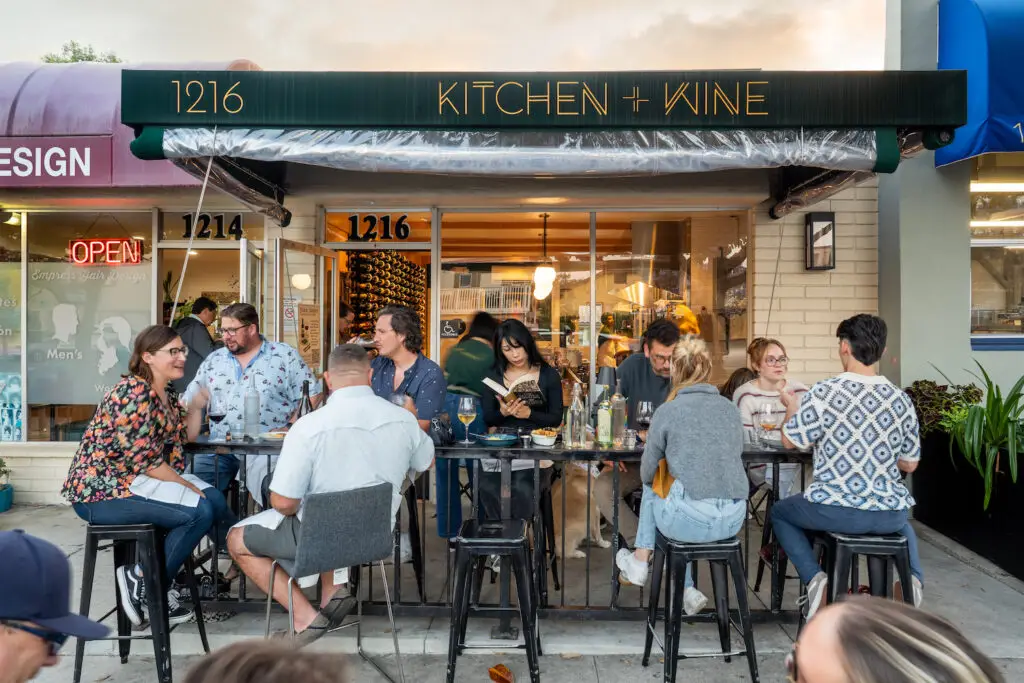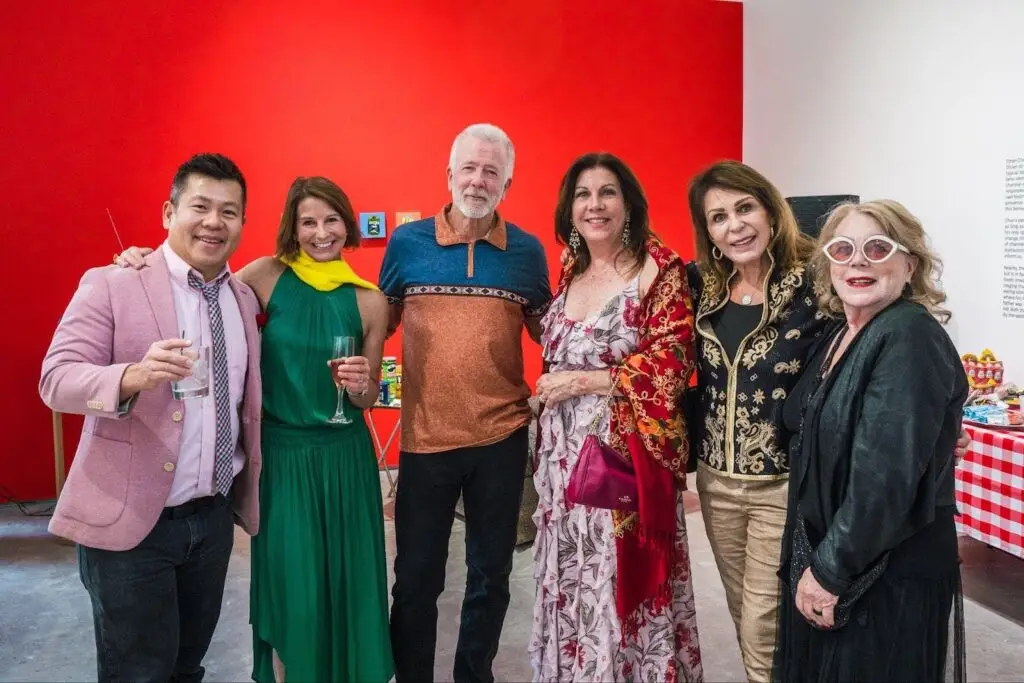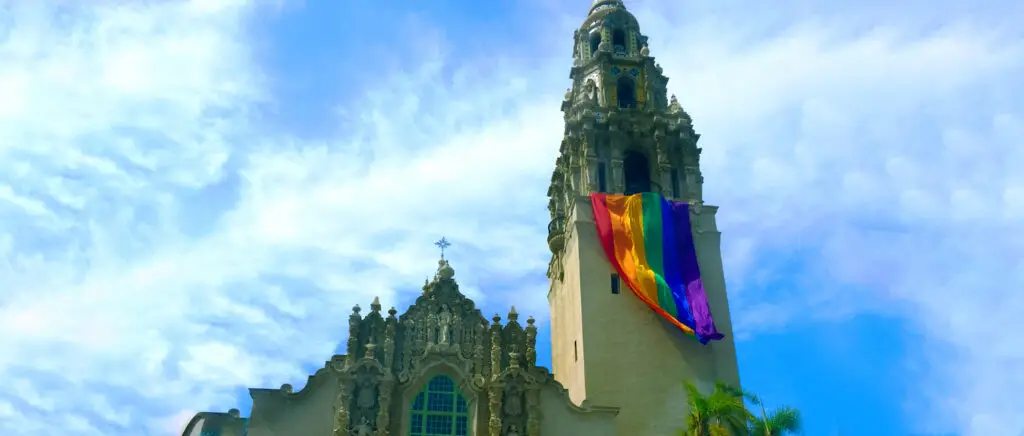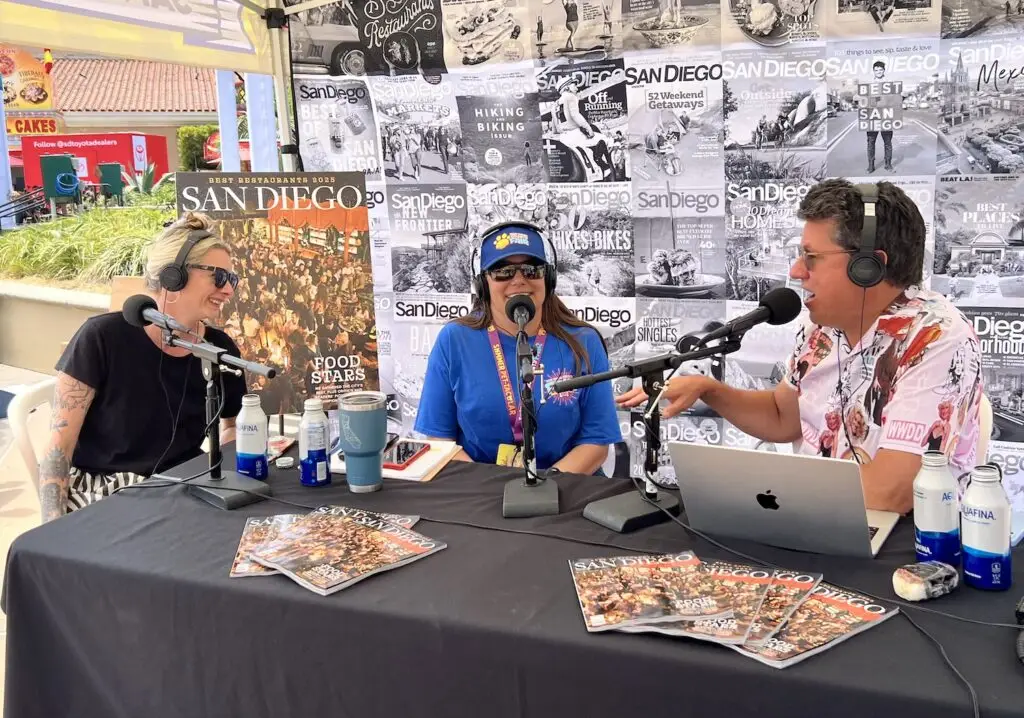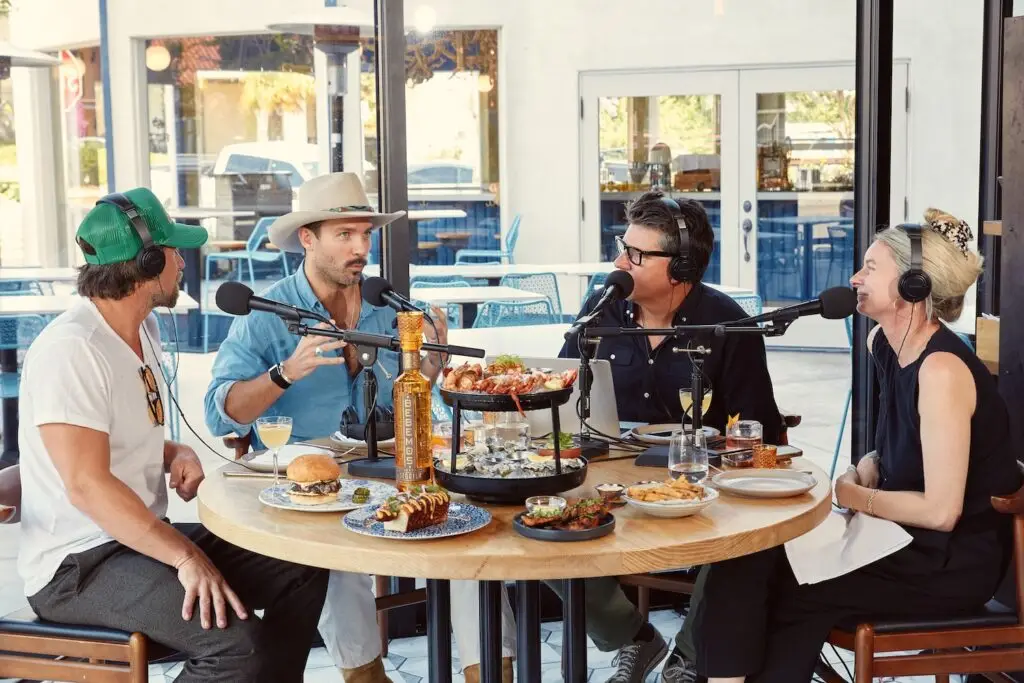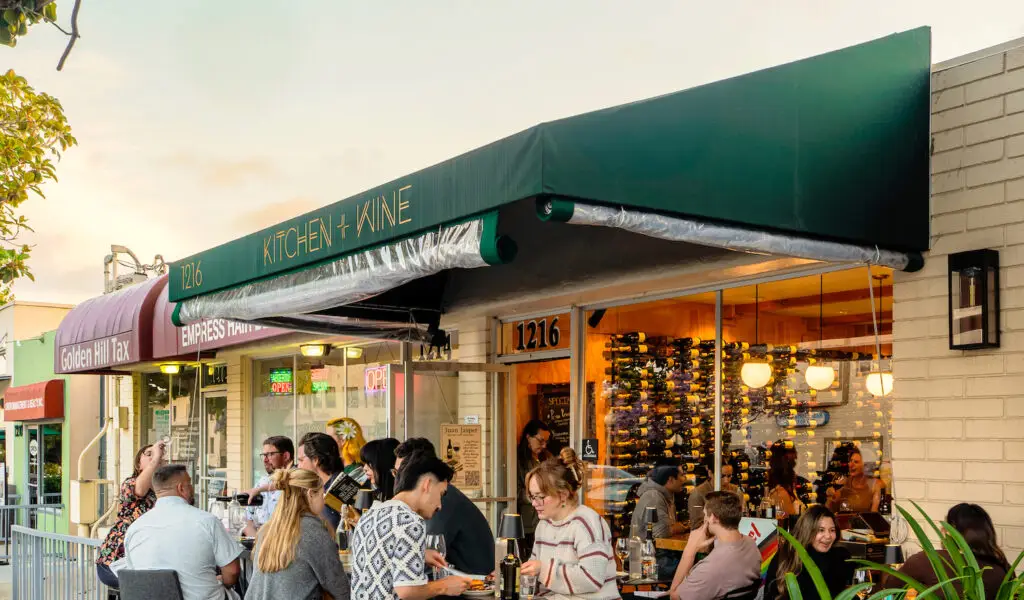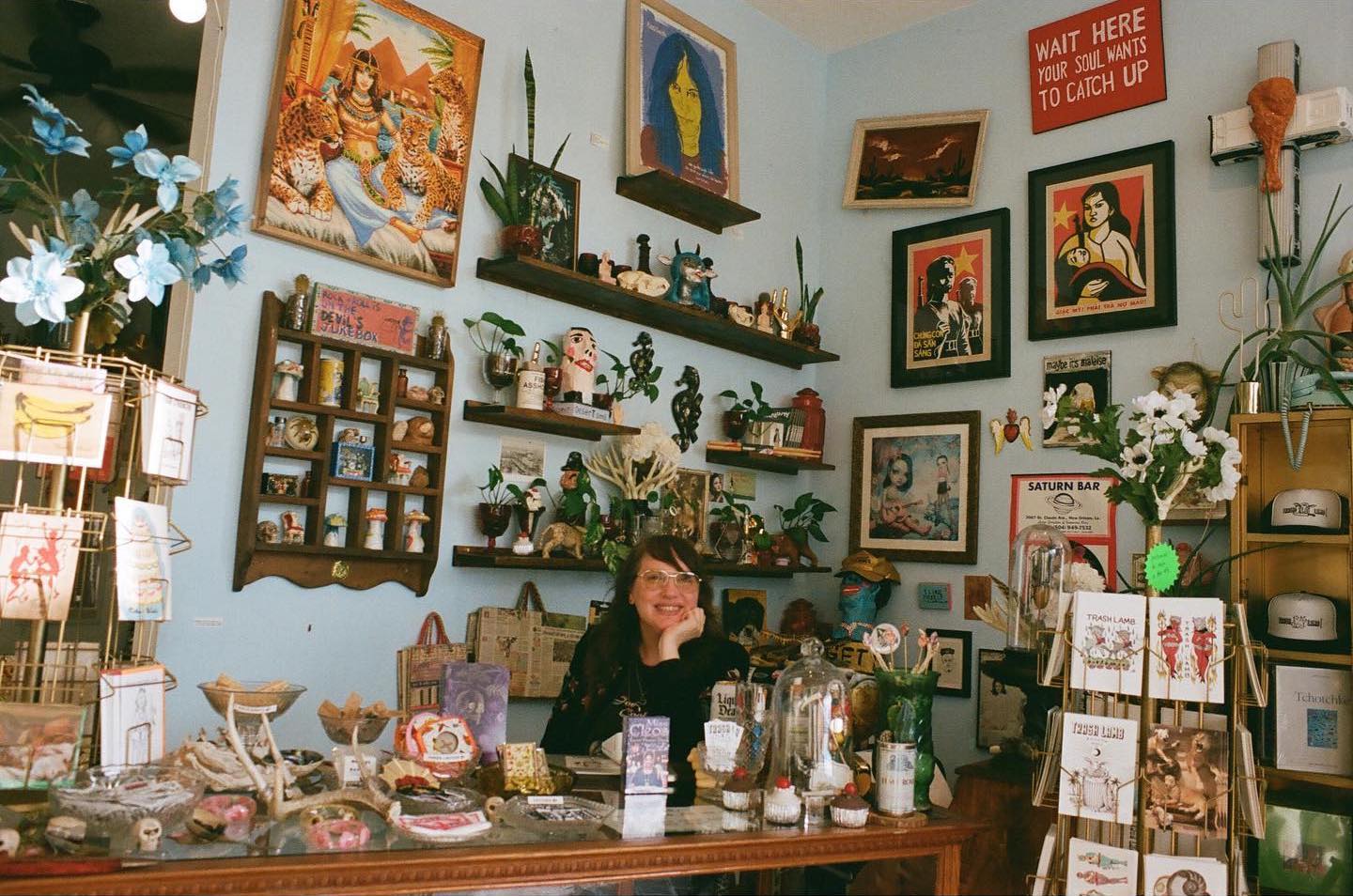You won’t see any sterile white walls here. You can barely see the walls, period, covered as they are in arresting, occasionally stomach-turning art: skulls and skinless bodies, a house on fire, a cheeky clock with an unprintable word prominently displayed. In a corner, a tennis racquet lamp by artist Jason Sherry casts its warm light into the room.
A far cry from the sleek, expansive spaces that typically show and sell art, Melody Jean Moulton’s small South Park storefront, Trash Lamb Gallery, feels a bit like visiting the apartment of your eccentric aunt with macabre and excellent taste. Prices range from less than $2 (for postcard prints of artists’ work) to the thousands, with stops at nearly every dollar amount in between.
“So many people have come in here and said, ‘Oh my god, this city needs this. I’m sick of seeing the same old thing,’” Moulton says.
Moulton, a collage artist, lost her job as a bartender at the onset of the pandemic. She never planned to start a business, until a retail space near her South Park apartment—and managed by the same landlord—became available. She didn’t have savings, but her network of friends chipped in to help make her dream a reality.
Her first exhibition at Trash Lamb, a group show, was a success. She credits the impacts of Covid, in part, for the flurry of interest she received during those early days. “I don’t know if I opened today if as many people would’ve been paying attention,” she says. “I got a lot of artists from all over the United States interested in having work in the show.”
That exhibition, and those that came after, helped establish Trash Lamb’s singular perspective in the local arts scene. But the past three years have been a crash course in business management for Moulton. In addition to curating shows and manning the register at Trash Lamb’s front-of-house gift shop, she manages the books and single-handedly created and maintains the gallery’s website and social media.
It’s a staggering amount of work, and Moulton can no longer run the show solo. In August 2023, she launched a GoFundMe asking for donations to fund a small staff and other assistance.
“The gallery is currently in dire [straits]. Without some immediate financial support, Trash Lamb will not make it to the end of the year,” Moulton wrote. “I believe in Trash Lamb so much that I would 100 [percent] take on more debt if I could … If we are able to become fully funded that will give Trash Lamb the opportunity to grow and make it past that quintessential [five]-year mark.”
At the time of writing, the crowdfunding campaign had generated nearly $20,000 (just under half of its $46,300 goal), carrying Trash Lamb into its fourth year. But unless she reaches her goal, the brick-and-mortar may shutter this April.
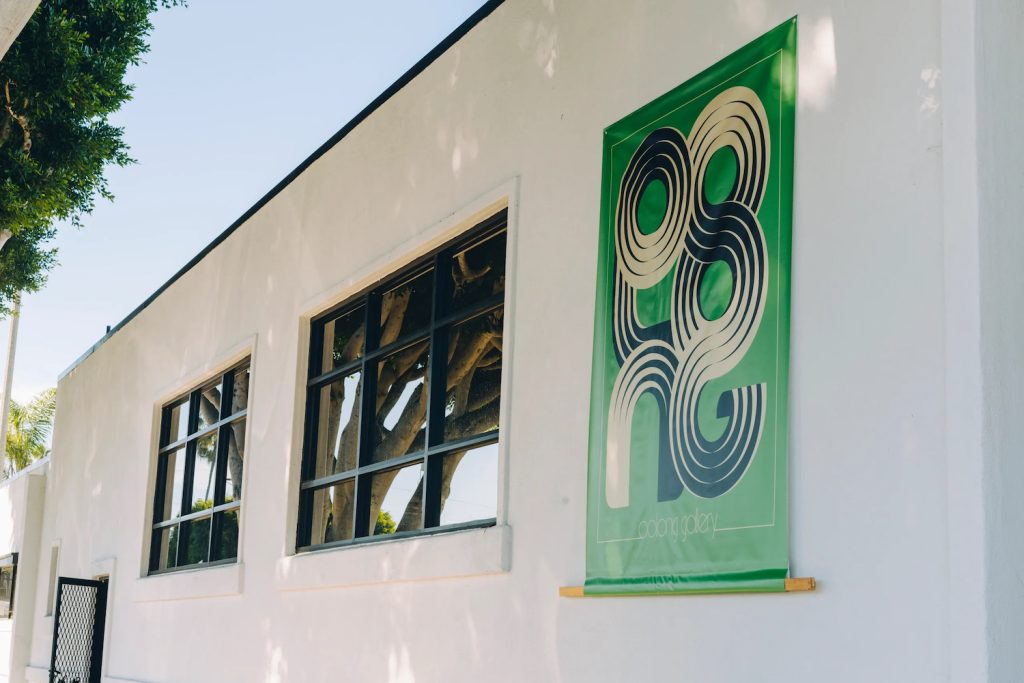
San Diego’s Struggling Art Spaces Are Part of a Larger Conversation
The question is, then, whether Trash Lamb’s trouble is a death knell or the same old song. Every industry—including the arts—has its ebbs and flows. The loss of Trash Lamb would be a personal tragedy for Moulton and the many artists, collectors, and shoppers who work with the gallery. But who’s to say that another art business wouldn’t simply arise in its place, as businesses tend to do?
There’s evidence, however, that it may be a particularly difficult time for art spaces in San Diego and beyond. The price per square foot for retail properties in San Diego rose 31 percent from 2022 to 2023, according to commercial real estate marketplace Crexi. And there are no laws limiting landlords from raising rates following the end of a lease, even for existing tenants.
Another commercial multiple-listing site, LoopNet, reported that the average cost to lease retail space in San Diego is about $35 for each square foot per year. At that rate, a gallerist renting a 600-square-foot property (about the size of a typical one-bedroom apartment) would shell out about $1,800 a month, but that doesn’t account for other expenses—or the fact that a lean square footage limits how much work you can show and, thus, sell.
When taking into account rent and other overhead, Eric Laine, the founder of newer North County space Oolong Gallery, cites the cost of running his business as “at least $10,000 a month.” All in all, maintaining a gallery requires tens or even hundreds of thousands of dollars a year in art sales, in a time when collector spending seems to be waning globally.
In the first five months of 2023, art auction sales decreased about 14 percent, Art Net reported, even at major houses like Christie’s and Sotheby’s, whose artists—Pablo Picasso, Jean-Michel Basquiat, and Willem de Kooning among them—command bids in the millions. Total art sales in the US dipped 25 percent from the same period in 2022.
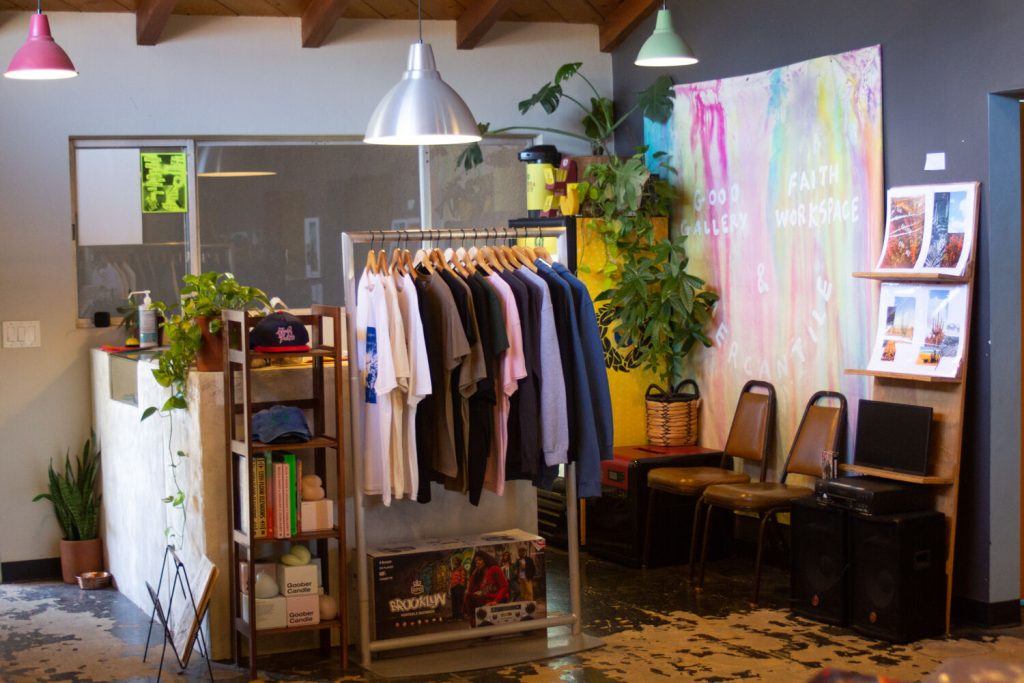
Losing Galleries Will Shrink a Crucial Launching Pad for Emerging Artists
In San Diego, Antonio Becker, the owner of Good Faith Gallery, has seen “a stark contrast” in the way consumers engage with his space since the pandemic, he says. Once-dedicated collectors may now spend less time at galleries and less money on art.
Taken together, soaring rents and stagnating sales could spell disaster for the entire industry—which could, in turn, impact emerging artists.
Almost half of all US museums focus on a mere four percent of contemporary artists, according to a 2022 study. Galleries (and, now, the internet) are one of the few spaces where newer or less commercially successful artists can show their work, generate buzz, and attract buyers and collectors.
“Commercial galleries in the US play a critical role in the careers of artists,” the study opined. “Unlike most museums, galleries are important from an early stage, and feature in the exhibition programs of artists all the way through their careers.”
According to Becker, galleries ultimately cater to the artist, as opposed to viewer-focused institutions like museums. “We’re propelling someone into the limelight for a short period of time,” he adds. “You see the impact it has on their lives. The DIY spaces, that’s where legends are made. That’s how people end up in the contemporary art museums.”
At eclectic local spots like Trash Lamb, visitors might peruse paintings from artists showing in a gallery for the first time alongside pieces from Jon Bok, a popular LA–based artist who has also shown at the Mingei International Museum in Balboa Park. They’re equal-opportunity playgrounds.
“Call them ‘alternative,’ ‘experimental’ or ‘nontraditional,’ these spaces are an essential part of an art ecosystem. They are … where young artists gain traction and established artists try out new concepts,” journalist Susan Myrland wrote for San Diego CityBeat in 2013. With the exception of North Park’s stalwart Art Produce and some galleries inside Bread & Salt, most of the newer spaces she mentions in the piece (along with CityBeat itself) have shuttered.
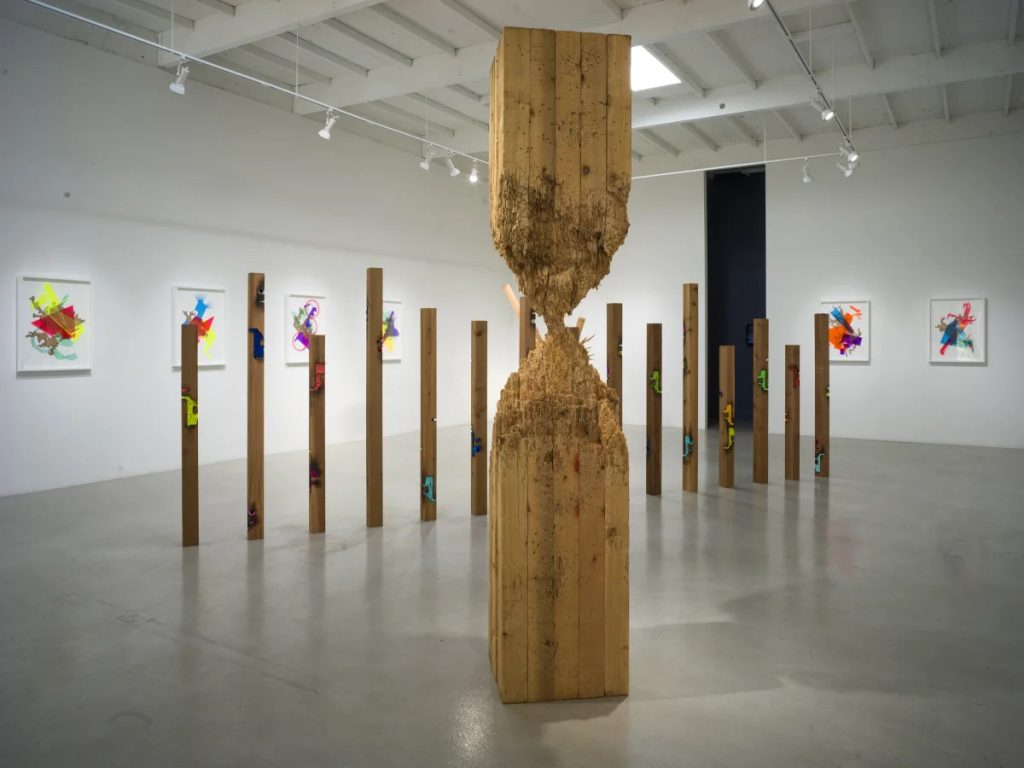
How Art Spaces Are Combating Rising Costs in 2024
So what can galleries do to survive? One option is to be adaptable. Local art world giant Mark Quint founded his eponymous gallery on Pearl Street in La Jolla in the 1980s, but it’s found a home in dozens of buildings over the decades. “He’s been around for over 40 years, and I think part of that is being so flexible and nimble and not sticking to one space,” says Quint Gallery Marketing Director Jacqueline Marino.
Contemporary arts space Oolong Gallery took a similar path. Laine launched Oolong in an airy Solana Beach building just as the pandemic waned, but with the combination of heavy car traffic and light foot traffic on the 101 and costly square footage in a lesser-used downstairs area, the gallery’s location in the area quickly became financially untenable. When a glass-walled warehouse in Encinitas became available via a “benevolent collector-slash-real-estate-mogul,” Laine says, he transplanted his operation, adopting a pop-up model.
Though the cost of living and doing business in San Diego continues to creep ever upward, some landlords are more amenable to the arts. When the North Park building that once housed Good Faith Gallery was sold, Becker met the owner of a property in Sherman Heights through another gallerist. “Honestly, I think that we’re able to still function because of his lenience and his goal to create a space for the arts,” Becker says.
Additionally, Good Faith provides studio space to several artists. It’s the rent they pay—more so than art sales or events—that keeps the gallery afloat. Moving forward, more businesses could lessen the traditional divide between arts institutions and art studios, building more artist-driven, collaborative spaces. Already, some LA galleries, such as Durden and Ray, operate on a co-op model, with each member artist or curator contributing financially to maintain the space.
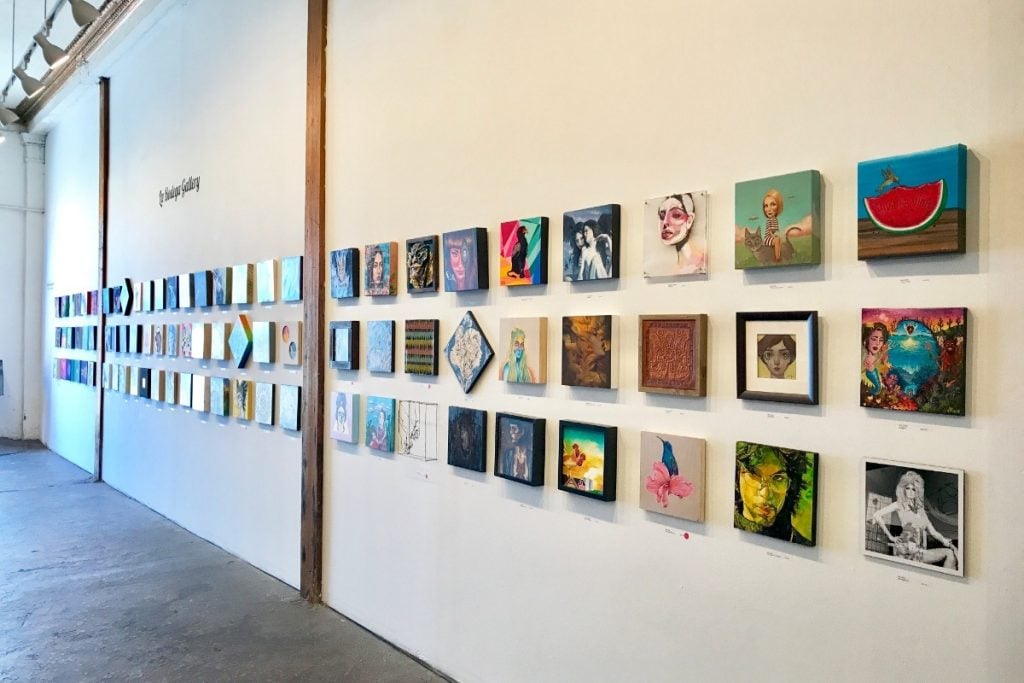
Paving a Path Forward Through Community Initiatives
It’s a future that artist Soni Lopéz-Chavéz can envision working particularly well in historically marginalized communities. Lopéz-Chavéz and her husband Chris Zertuche ran the now-legendary La Bodega Gallery, a bustling arts space in Barrio Logan, for six years. Mounting new shows each weekend, they platformed thousands of artists and helped transform Logan Avenue into the hub it is today.
But as the area increased in popularity, property owners realized they could rake in more from tenants. La Bodega’s landlord tripled the building’s rent, forcing Lopéz-Chavéz and Zertuche out of the space. Other small galleries in the area folded shortly after. The neighborhood’s vibrant arts scene lives mostly in stories now.
“Barrio Logan is no longer the same,” Lopéz-Chavéz says. “If someone new wants to come in, they’re going to have to come in with a lot of money, which is unrealistic for a lot of us brown or Black folks. I think if a group of people got together and opened up a space together, then it might be easier.”
On a broader level, Alessandra Moctezuma—gallery director and professor at San Diego Mesa College and a representative for District 3 of the San Diego Arts Commission—hopes to see more governmental support for galleries and other small arts spaces.
“Right now, the city is working on a cultural plan,” she says. “[The team behind it] has started to think of some ways to financially help arts spaces,” even those that are for-profit. She would like to see the commission create a comprehensive gallery directory and make a full-time marketing hire whose role is to promote cultural tourism in San Diego.
Long-term, she adds, convincing major players—including governmental organizations and major corporations—of the necessity and value of art could lead to massive shifts in the way art is funded and supported. It may be the key to preserving spaces for emerging artists. Might massive biotech companies someday sponsor art shows? Could money be allotted to subsidize gallery spaces, particularly those that offer art lessons, activities for children, or other ways for the community to engage directly with the arts?
In the meantime, galleries, even those owned by individuals, can find more secure footing by banding together. “Our society is based on this very competitive model,” Moctezuma says. “But if you really want to create synergy and have people go and see the galleries, we have to foster a more collaborative model.” Approaches as simple as communicating to ensure galleries several neighborhoods apart aren’t scheduling openings on the same day could help the scene across San Diego feel less atomized—and lead to some powerful cross-promotion.
Community, after all, might be the key to saving spaces like Trash Lamb. Most of the gallery’s donors have been artists and fellow small business owners. Those who were unable to give financially offered free works of art, which Moulton was able to sell without providing a commission to the artist, or helped Moulton host fundraisers and auctions.
“I gave to Trash Lamb Gallery [because] it is talented independent local living artists sharing their art and vision of where we live, and I want to see more of that,” says local software developer Joe Crawford, a contributor to Trash Lamb’s campaign. “Working people are struggling and that means artists are struggling. San Diego has a history of similar spaces. But then the rent goes up or a landlord cancels a lease. I want to see Trash Lamb beat those odds. We’re a rich city, rich state, and rich country, but often it’s left to small donations from individuals to support the arts.”
The aid from those who share her values may help Moulton keep marching on while still doing things her way: avant-garde, bold, welcoming to anyone who’s ever felt out-of-place, in art or in the world.
PARTNER CONTENT
“It’s important to me to keep [art] accessible to everyone,” Moulton says. “I don’t know if that’s the most solid business plan, but it’s what I want to do.”
Correction: An earlier version of this article mistakenly cited the average cost of leasing retail space in San Diego as $35 per square foot per month, rather than per year.
